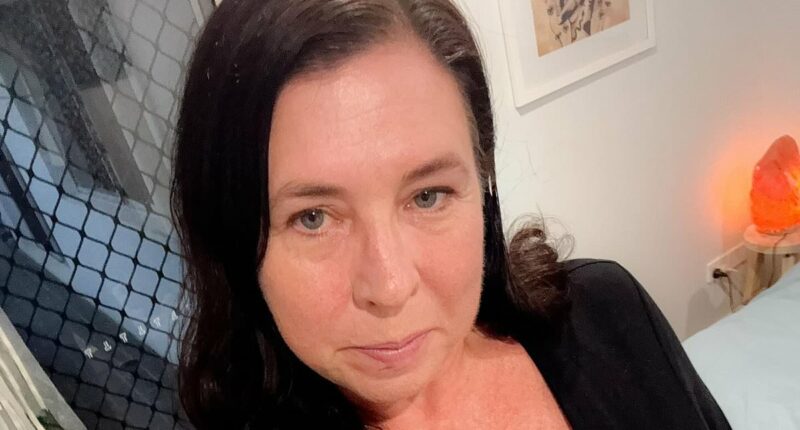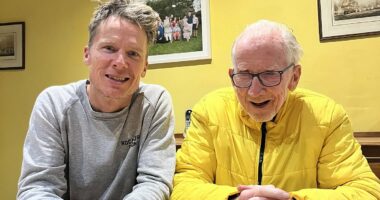Share this @internewscast.com
Throughout her childhood, Cara Szellemes felt constantly misunderstood and like the ‘odd one out’.
It wasn’t until she was in her mid-40s that she began to understand why.
‘Growing up, I always felt like I was either too much or never quite enough. It seemed like I constantly had trouble navigating life,’ shared the Queensland mother-of-three with Daily Mail.
‘It’s frustrating because no matter how hard you try, you seem to somehow stuff it up and get it wrong.’
Consequently, Cara had massive self-esteem issues, was bullied at school and lacked confidence.
By age four, doctors diagnosed her with ADHD, referred to back then as ‘hyperkinetic disorder,’ and she had to deal with the effects of the medication prescribed to her.
‘Initially, my mom put me on medication, but she noticed it made me seem like a zombie. I remember feeling detached, like having an out-of-body experience. My mom noted it changed my personality, making me more robotic,’ Cara recounted.
‘For that reason, Mum made the decision to take me off the medication after a few weeks. I haven’t taken any medication since.’

Cara Szellemes (pictured) received her ADHD diagnosis at four but only began earnestly learning to manage her condition in her mid-40s.
Cara appreciates her mother’s awareness of how the medication was adversely affecting her. At 45, she experienced a shift when she focused on personal growth.
She discovered that managing her ADHD was most effective through activities emphasizing movement, such as ecstatic dance—a dance environment where participants move freely without judgment or specific steps—as well as hiking, meditation, and somatic therapy, which is a body-centered approach using physical sensations and movement to address trauma and stress.
‘Out of everything, I’d say dancing is the best because it helps move the energy in my body and helps me process my emotions,’ she explained.
Every morning, Cara goes for a walk while listening to a meditation or mindset podcast. She practises gratitude when she gets home, then she has a healthy smoothie.
To better concentrate at work, she requires noise-cancelling headphones, otherwise she can hear ‘everything’ that’s being said around her and can’t focus.
Every weekend, she prepares nutritious meals for the week ahead, goes hiking in the rural hinterland where she lives, and moves her body through dance. She has also recently taken up comedy improvisation, which she finds therapeutic.
ADHD causes Cara to be forgetful. Sometimes it’s just a case of forgetting where she left her keys, but on one occasion she forgot to turn the oven off, and was out for hours after her car broke down.
Another ADHD symptom Cara manages through movement is hyperfocus – a state where she becomes so absorbed that she neglects basic needs like eating or using the bathroom.

Now 57, Cara told Daily Mail she is able to manage her ADHD through a combination of factors all centred around movement, including ecstatic dance, hiking, somatic therapy and meditation
‘If you’re in hyper-focus mode and not self-aware enough to recognise when you need to pull back – which happens to most people with ADHD – it’s a ripple effect and can be a downward spiral,’ she said.
If she doesn’t intervene, stress builds, leading her to ‘spiral into shame’ before she abandons the task.
In the past, she would have ‘powered through’ – but now movement helps her recognise when to pause.
Max Phelps’ ADHD diagnosis came later in life, and he has also used exercise to manage the side effects.
He only investigated his symptoms in 2022 after his son was diagnosed at the age of 31. The specialist mentioned that ADHD is hereditary and he began to examine his own struggles with focus.

Max Phelps’ (pictured) diagnosis came later in life, and he has used exercise to manage it
The 57-year-old told Daily Mail that ADHD was never discussed when he was a student at school and he found it difficult to focus during lessons.
‘I’ve never been medicated, but I have managed my ADHD with a combination of massive amounts of exercise, OCD-type routines and surrounding myself with a team that tells me what to do, even though I’m technically the boss,’ he said.
‘I’ve found I must avoid anything that throws me off – which means no alcohol, no caffeine and obviously no drugs. Any of these can quickly go from just the one to all-in very quickly.’
Max added that cutting out stimulants has helped his ADHD immensely.
‘[The diagnosis] made a lot of things make sense to me, such as my ability to instantly access all areas of my brain simultaneously, which is great for brainstorming and cracking unexpected jokes,’ he said.
‘I also can’t stop looking at screens in pubs even if I’m talking with good friends. I manage to simultaneously watch rugby league, AFL and darts on different screens, while trying to eat dinner and listen to conversations.’
From a business perspective, he said it’s great for ‘seeing patterns that others don’t’ but also means he’s a ‘gifted procrastinator’.
The game-changer for him has been exercise.
‘Not having any stimulants such as alcohol and coffee has helped, but my normal exercise routine is huge. If I can’t exercise for a couple of weeks, I really struggle,’ he said.
Max’s new office is 12.5km from home, so he either runs or cycles to work every day.
On Tuesdays, he plays football. On Thursdays, he does an hour of dragon-boat paddling. He dances for up to three hours on Friday nights.
The weekends include more football and plenty of hiking.
‘I realised at 21 that alcohol wasn’t good for me and quit. I’ve quit caffeine twice, because my capacity for it is unlimited,’ he said.
Max now enjoys herbal teas instead.

Melbourne counsellor Lukas Winward told Daily Mail that movement is ‘one of the best regulators’ for tackling ADHD as it quickly shifts and resets the mind
THE SOLUTION? MOVEMENT
Melbourne counsellor Lukas Winward told Daily Mail that movement is ‘one of the best regulators’ for tackling ADHD as it quickly shifts and resets the mind.
‘When you exercise, the brain naturally releases dopamine and norepinephrine, which are the same chemicals that ADHD medications target,’ he said.
‘Movement just shifts you so quickly. All it takes is 20 minutes a day, or as much as you need to, but it takes discipline. Consistency beats everything.’
Lukas was diagnosed with ADHD at 14, which made it difficult to focus in the classroom.
‘I was the naughty kid, the class clown who was always getting kicked out of lessons. I was disengaged in the classroom – an intelligent kid but always bored. I felt like a square peg trying to fit through a round hole,’ he said.
‘Now I understand what it was. I can catch myself and shift my mindset.’
Lukas says movement gives people a way to ‘channel restlessness instead of fighting against it’ – which helps with focus.
‘It’s about the mind-body connection, scanning yourself to see what sort of state you’re in, then asking, “What can I do to shift that?” In my opinion, it’s always movement.
‘For example, one morning my nine-year-old daughter, who’s going through a massive growth spurt, was extremely tired and wasn’t feeling great. I got her in the backyard jumping up and down, doing spaghetti arms, and in 20 seconds she was laughing, and everything shifted.’
For those with ADHD, Lukas says cardio movements can help sharpen focus, strength training can shape discipline, and yoga and breathwork can assist with cooling the nervous system.
Other tactics, such as splashing cold water on your face in the morning, help to engage your vagus nerve, calming the nervous system and sharpening focus.
Lukas also stresses the importance of having structure and routine.
Over the last 12 years working with clients with ADHD, Lukas has noticed what movements are most helpful, depending on someone’s age.
‘One of my clients was in his 60s when he was diagnosed and when the penny dropped it all made sense why he found it hard sitting in meetings at work,’ he said.
‘So when he estimated a meeting would go for longer than ten minutes, he’d be on the call while going for a walk. That simple adjustment was insane for him because he was able to focus and be present.’
As for the teenagers he’s worked with, Lukas encourages them to ditch video games, which involve no movement at all, and instead play basketball outside.
For children 12 and under, the idea is the same, but movement is age-appropriate and fun.
‘You want it to be a bit of fun. If it’s boring and it’s rigid, then they’re not going to do it. So embracing the inner child when you’re talking to them is really important. For children, it’s more about spaghetti arms, jumping jacks, star jumps, and being a bit silly with it,’ Lukas said.
His biggest recommendation is to start small and begin with moving 20 minutes a day.
‘Put something in your calendar, block out two weeks and commit. Don’t, as some people do, start with grand plans; start small and be realistic,’ he said.
‘Once you start to see the benefits and feel better, it’ll be easier to build on and you’ll naturally want to do more.’
It is recommended to seek medical attention and guidance from your GP to discuss what is right for you. Exercise and diet alone should not replace medication for ADHD if it is required.
















